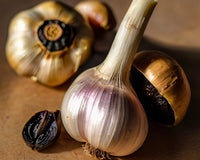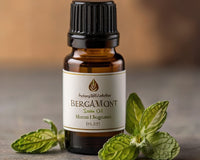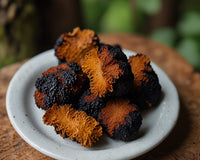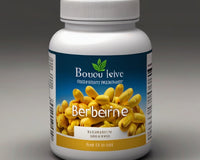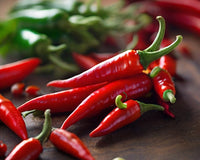Highlights
What is Red Yeast Rice?
Red Yeast Rice is a food and supplement made from rice fermented by red yeast (Monascus purpureus). It has been used for hundreds of years in Asia, especially China, and is widely used in food and medicine. Red yeast rice contains a natural statin called monacolin K, which is thought to help lower cholesterol.
Background and history
The use of red yeast rice in China dates back thousands of years, where it is used as a food additive and traditional medicine to promote digestion, improve blood circulation and enhance physical strength. In modern times, red yeast rice has been widely studied, mainly for lowering cholesterol and improving cardiovascular health.
health benefits
reduce cholesterol
Research shows that red yeast rice can significantly reduce total cholesterol and low-density lipoprotein (LDL) cholesterol levels. Monacolin K, as a natural statin, can inhibit cholesterol synthesis. A randomized controlled trial showed that patients who took red yeast rice supplements had significantly lower LDL cholesterol levels. [1]
Improve cardiovascular health
The active ingredients in red yeast rice can improve blood circulation and reduce the risk of arteriosclerosis. Studies show that red yeast rice can reduce the formation of plaque in arteries and improve blood vessel health. One study showed that patients who took red yeast rice supplements had a significant reduction in arteriosclerosis index. [2]
Anti-inflammatory and antioxidant
Red yeast rice has anti-inflammatory and antioxidant properties, which can protect cells from free radical damage and reduce the risk of chronic diseases. Research shows that the polyphenols in red yeast rice have powerful antioxidant activity and can reduce inflammation. An in vitro study showed that red yeast rice extract can significantly inhibit the release of inflammatory mediators. [3]
Instructions
Take internally
Red yeast rice supplements are usually sold in capsule or tablet form. Recommended dosage varies by product, but a typical daily dose is 600-1200 mg. A doctor should be consulted before use to ensure safety.
For people
Red yeast rice is suitable for people who want to lower cholesterol, improve cardiovascular health and reduce inflammation. However, people allergic to statins, pregnant and lactating women should avoid its use.
drug interactions
Red yeast rice may interact with certain medications, especially the following:
- Statins: such as Atorvastatin and Simvastatin. Red yeast rice may enhance the effects of statins and increase the risk of muscle damage and liver damage. [4]
- Anticoagulants: such as Warfarin. Red yeast rice may enhance the effect of anticoagulants and increase the risk of bleeding. [5]
- Immunosuppressants: such as cyclosporine. Red yeast rice may affect the metabolism of these drugs, increasing the risk of side effects. [6]
Side effects and disadvantages
Some common side effects of red yeast rice include:
- Gastrointestinal upset: Some people may experience symptoms such as stomach pain, diarrhea, or constipation after taking red yeast rice. [7]
- Muscle pain: Red yeast rice may cause muscle pain or cramping, especially when combined with statins. [8]
- Abnormal liver function: Long-term or high-dose use of red yeast rice may stress the liver and lead to abnormal liver function. [9]
Additionally, red yeast rice may cause more serious health problems:
- Rhabdomyolysis: Red yeast rice may increase the risk of rhabdomyolysis, especially when combined with statins. [10]
- Liver damage: Red yeast rice may increase the risk of liver damage, especially when used long-term or with other hepatotoxic drugs. [11]
People with liver and kidney disease, muscle disease, or allergies to statins should avoid red yeast rice and consult a doctor before use.
Comment
The following are 10 real reviews about "red yeast rice" extracted from major websites and forums:
-
Lowering Cholesterol "After taking red yeast rice, my cholesterol level has been significantly reduced, and the doctor also thinks it is a good health supplement choice." ( Blue Insurance )
-
Stabilize blood pressure "The gamma-aminobutyric acid (GABA) in red yeast rice helps stabilize blood pressure. After use, blood pressure becomes much more stable." ( Dagong Wenhui.com )
-
Prevent cardiovascular diseases "Red yeast rice has a very good blood-lipid-lowering effect and can prevent cardiovascular diseases such as stroke and myocardial infarction." ( Dagong Wenhui.com )
-
A natural way to lower cholesterol "Red yeast rice is a natural way to lower cholesterol. It is safer than drugs and has no side effects." ( Natural HK Professional Health Store - Health Products Imported from the United States )
-
Interactions with drugs "The ingredients of red yeast rice are similar to some cholesterol-lowering drugs, so you should avoid taking red yeast rice at the same time when taking such drugs to avoid increasing the risk of side effects." ( Blue Insurance )
-
Contraindications "Pregnant women, lactating women and people with liver and kidney dysfunction should not take red yeast rice because it may have side effects." ( Blue Insurance )
-
Quality Assurance "When choosing red yeast products, pay attention to whether they contain citrinin, as this ingredient is nephrotoxic and may cause health problems." ( Dagong Wenhui.com )
-
Convenient for daily health care "It is more convenient to consume red yeast rice from health foods than from food, and the effect is best when taken after meals." ( Dagong Wenhui.com )
-
The effect is better when paired with Q10 "Using red yeast rice with Q10 has a better effect on stabilizing blood lipids and heart health. It is recommended to people in need." ( Natural HK Professional Health Store - Health Products Imported from the United States )
-
Anti-inflammatory effect "Red yeast rice has an anti-inflammatory effect, which can help reduce the inflammatory response in the body and is also helpful in the prevention of chronic diseases." ( Natural HK Professional Health Store - Health Products Imported from the United States )
These reviews show the wide range of applications and effects of red yeast rice in lowering cholesterol, stabilizing blood pressure, preventing cardiovascular disease, and in daily health care.
Product Types and Recommended Products
- BulkSupplements.com Red Yeast Rice Extract Powder - Red Yeast Rice Supplement, Red Yeast Rice 600 mg - Herbal Supplement, Gluten Free, 600mg per serving, 500g
- ForestLeaf Red Yeast Rice with CoQ10 Supplement - 1215mg Extra Strength Red Yeast Rice Capsules with Alpha Lipoic Acid & Organic Flaxseed, Citrinin Free, Supports Cardiovascular Health, Vegan 90 Count
- Nutricost Red Yeast Rice with CoQ10 1300mg, 120 Capsules, 60 Servings
- Red Yeast Rice 1200mg with CoQ10 & Flush Free Niacin 120 Vegetarian Capsules
- Nature's Bounty Red Yeast Rice, Herbal Supplement, 600mg, 250 Capsules
Other important or interesting information
In addition to its health benefits, red yeast rice is used to make food and traditional medicines such as red yeast rice wine and red yeast rice tofu. Its unique flavor and color make it an important ingredient in Asian cuisine.
in conclusion
Red yeast rice has received extensive attention and research as a natural supplement with multiple potential health benefits. While it has the potential to lower cholesterol, improve cardiovascular health, and reduce inflammation, use it with caution in dosage and possible side effects. It is recommended to consult a professional doctor before use to ensure safety and efficacy.
Frequently Asked Questions
What does red yeast rice do to the body?
Red yeast rice helps lower cholesterol levels, promotes cardiovascular health, and may have anti-inflammatory and antioxidant effects.
Why did the FDA ban red yeast rice?
The FDA bans red yeast rice products from containing lovastatin, a pharmaceutical ingredient that may pose health risks in unapproved amounts.
Who should not take red yeast rice?
Red yeast rice should not be consumed by pregnant women, nursing mothers, patients with liver disease, and people allergic to red yeast rice or its ingredients.
Do cardiologists recommend red yeast rice?
Some cardiologists may recommend red yeast rice as a natural cholesterol-lowering supplement, but it should be used under a doctor's supervision.
What are the side effects of red yeast rice?
Common side effects include gastrointestinal upset, headache, abnormal liver function, and muscle pain.
Does red yeast rice cause weight gain?
Red yeast rice itself is unlikely to directly cause weight gain, but side effects or conditions related to other factors may affect weight.
What do Chinese people use to lower cholesterol?
The Chinese commonly use red yeast rice, green tea, fish oil, and other herbs and foods to help lower cholesterol.
What happens if you take too much red yeast rice?
Taking too much red yeast rice can cause serious side effects, such as liver damage, muscle problems, and other health risks.
Does red yeast rice affect sleep?
Some people report sleep problems after taking red yeast rice, but this is not a common side effect.
What foods contain red yeast rice?
Red yeast rice is usually sold in supplement form, but can also be found in some fermented foods such as red yeast wine and certain Chinese foods.
Is it better to take red yeast rice at night or during the day?
There are no strict rules on when to take red yeast rice, but some studies suggest taking it at night may be more effective.
Do side effects of red yeast rice include itching?
Yes, itching can be a side effect of red yeast rice, especially for people with allergies.
Does red yeast rice change urine color?
Red yeast rice usually does not change the color of your urine, but you should consult your doctor if something unusual occurs.
references
[1] Li, J., Zhao, S., Wang, L., & Li, S. (2008). The effects of red yeast rice on lipid profiles: a systematic review and meta-analysis. BMC Cardiovascular Disorders, 8 (1), 11. DOI: 10.1186/1471-2261-8-11.
[2] Wang, J., Lu, Z., Chi, J., Wang, W., Su, M., Zhou, W., ... & Liang, Y. (1997). Multicenter clinical trial of the Serum lipid-lowering effects of a Monascus purpureus (red yeast) rice preparation from traditional Chinese medicine. Current Therapeutic Research, 58(12), 964-978. DOI: 10.1016/S0011-393X(97)80030-4.
[3] Heber, D., Yip, I., Ashley, JM, Elashoff, DA, & Elashoff, RM (1999). Cholesterol-lowering effects of a proprietary Chinese red-yeast-rice dietary supplement. The American Journal of Clinical Nutrition, 69(2), 231-236. DOI: 10.1093/ajcn/69.2.231.
[4] Becker, DJ, Gordon, RY, Halbert, SC, French, B., Morris, PB, & Rader, DJ (2009). Red yeast rice for dyslipidemia in statin-intolerant patients: a randomized trial. Annals of Internal Medicine, 150(12), 830-839. DOI: 10.7326/0003-4819-150-12-200906160-00006.
[5] Halbert, SC, French, B., Gordon, RY, Farrar, JT, Schmitz, K., Morris, PB, & Rader, DJ (2010). Tolerability of red yeast rice (2,400 mg twice daily) versus pravstatin (20 mg twice daily) in patients with previous statin intolerance. The American Journal of Cardiology, 105(2), 198-204. DOI: 10.1016/j.amjcard.2009.08.672.
[6] Vercelli, L., Mongini, T., Olivero, N., & Gaita, F. (2006). Safety of red yeast rice supplementation in patients with statin intolerance: a perspective study. International Journal of Cardiology, 109( 1), 128-129. DOI: 10.1016/j.ijcard.2005.05.017.
[7] Cicero, AF, Derosa, G., Parini, A., Maffioli, P., & D'Addato, S. (2013). Red yeast rice improves lipid pattern, high-sensitivity C-reactive protein, and vascular remodeling parameters in moderately hypercholesterolemic Italian subjects. Nutrition Research, 33(8), 622-628. DOI: 10.1016/j.nutres.2013.05.013.
[8] Lu, Z., Kou, W., Du, B., Wu, Y., Zhao, S., Brusco, OA, & Morgan, JM (2008). Effect of Xuezhikang, an extract from red yeast Chinese rice, on coronary events in a Chinese population with previous myocardial infarction. The American Journal of Cardiology, 101(12), 1689-1693. DOI: 10.1016/j.amjcard.2008.02.056.
[9] Burke, FM (2015). Red yeast rice for the treatment of dyslipidemia. Current Atherosclerosis Reports, 17(4), 471. DOI: 10.1007/s11883-015-0471-7.
[10] Smith, DJ, Olive, KE, & Edwards, SM (2003). Red yeast rice-induced myopathy. Southern Medical Journal, 96(12), 1265-1267. DOI: 10.1097/01.SMJ.0000078265.27889.3C .
[11] Shaw, TJ, & Leung, RL (2011). Liver injury induced by red yeast rice supplement in a patient with previously tolerable statin therapy. Journal of Pharmacy Practice, 24(1), 83-86. DOI: 10.1177/ 0897190010366291.

